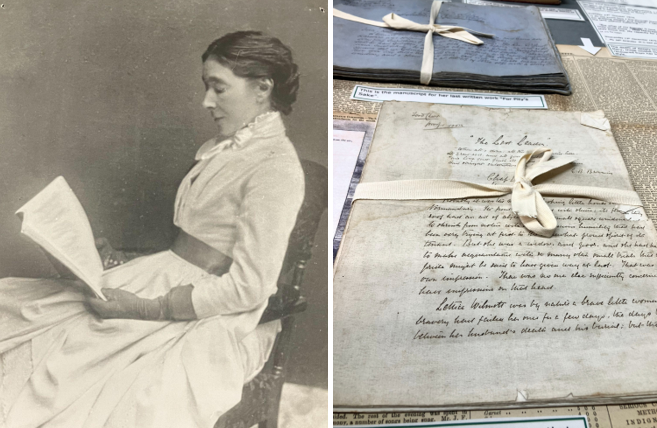
When thinking of the great writers associated with Whitby, prolific names such as Bram Stoker, Elizabeth Gaskell or Lewis Carroll may come to mind. But another writer, by the name of Mary Linskill, also contributed invaluably to Whitby’s literary heritage. Much of Linskill’s work is now out of print, her name largely overlooked in the 21st century. Yet, at the Whitby Library and Archive, we can continue to learn about her life and legacy. The Archive holds a fascinating collection of manuscripts, images, diary entries and exhibition materials, inviting us to re-examine this remarkable woman.
About Mary
Mary Linskill was born in Whitby on December 13th 1840. She lived with her father, Thomas Linskill, and mother, Mary Ann Linskill, at Blackburns Yard. At the age of sixteen, she started an apprenticeship as a milliner with Mr Charles Wilson. After seven years in this trade, she took up work as a schoolteacher and then governess, moving to Nottinghamshire and Derby. Following this, she moved back to Whitby, also living in the nearby towns of Ruswarp and Newholm, where she was pleased to escape the hustle and bustle of the fishing town. She then turned her focus to writing (Quinlan and Humble, 10, 1968).

The earliest known portrait of Mary Linskill, taken from a larger photo of her with her family
In all, Linskill published thirteen novels and eight smaller works. Her first piece ‘Tales of North Riding’ in 1871, was published under the pseudonym Stephen York, which was common practice for many women writing in those days. Following this, her novels Between the Heather and the Northern Sea (1884) and The Haven Under the Hill (1886) achieved remarkable success. The latter is set in the fictional town of Hilds Haven, which is actually based on the town of Whitby that Linskill knew so well.
Objects from the Archive
Inside the Whitby Library and Archive we have three archival boxes full of interesting documents, images, manuscript and diary entries which paint an insightful picture into Mary’s life. From these, objects have been taken to create our current exhibition, which can be found inside the Library cabinet. This showcases information about Linskill not only as a writer, but also as a daughter, a friend and remarkably deep thinker.
Original manuscripts held by the Archives shed light into Mary’s writing processes. These include texts from her works ‘The Lost Leader’ and ‘Robert Holt’s Illusion’. In addition, ‘For Pity’s Sake’, Linkskill’s final piece, which was published posthumously, is displayed in the current Library and Archive exhibition. The piece was written on individual sheets of beautiful blue paper with intricate detail; one can imagine Linskill sitting at her writing desk beautifully crafting her story.

Mary Linskill in White
One of the three archival boxes is filled with documents from Mary Linskill’s Centenary exhibition, held in Whitby Museum in April 1991.This was ‘A major exhibition to celebrate the centenary of the distinguished Whitby born novelist. The story of her life and work is told with the help of her paintings, manuscripts and books and with rare early photographs never before seen by the public’ (Poster, Whitby Museum Archive).
In addition, snippets from Linkskill’s diary, also presented in the current exhibition, reveal that she was unhappy and struggling financially. Entries from 1876 outline that she did not want to invite friends round to the house, ‘having neither tea nor butter’, showing her despair at her difficult financial situation and her self-image. In addition, her health was clearly deteriorating; she states ‘I am so ill that I cannot work’, ‘I do not know how to live through these hours of horror. I am growing weaker and weaker’. A poignant entry from December 13th 1876 states: ‘My 36th birthday. Ill in bed all day’ (Linskill, M. 1876).
It is clear from these entries that Linkskill was unhappy at the time she wrote them, revealing important details about her life. Are these snippets representative of her broader personality, or just her thought process on those difficult days? Since not much of her diary remains, our understanding of her Linskill remains fragmented and mysterious.

Mary Linskill reading, photographed by Frank Meadow Sutcliffe
Legacy
Linksill died at the age of 50 on 9th April 1891. She was buried in Whitby Cemetery, Larpool Lane, which remains open to visitors today. Within Linskill’s biography, Cordelia Stamp writes:
‘Despite her undoubted success as a writer, Mary had never managed to earn enough money to pay off the entire legacy of debt which her father had left. She never made a will, for she had nothing to bequeath save her books- and they had already been given to the world’ (115: 1980).

Linskill’s Grave in the Whitby Cemetery
Over time, Linskill has become a rather obscure name, particularly for those who live outside of Whitby and Yorkshire. Yet, searching through archives can help us piece together more information about the real Mary Linskill, recognising her talents as well as her difficulties. Indeed, this helps us to understand the real woman behind the manuscripts and stern looking photos. With the Whitby Literary Festival coming up (6th – 9th November 2025) now seems a pertinent time to re-acknowledge an author who achieved notable success and inspired many generations following her.
Written by Emily Fielding, volunteer, MPhil Heritage Studies
References:
Linskill’s, M. (1876). Diary. Whitby Museum and Archives, B7.5.
Centenary Poster: Whitby Museum and Archives, B7.5.
Stamp, C. 1980. Mary Linkskill: 1840-1891. Caedmon Reprints, Whitby.
Quinlan, D. and Humble, A. 1969. Mary Linkskill, The Whitby Novelist. Horne and Son, Ltd. Whitby.



